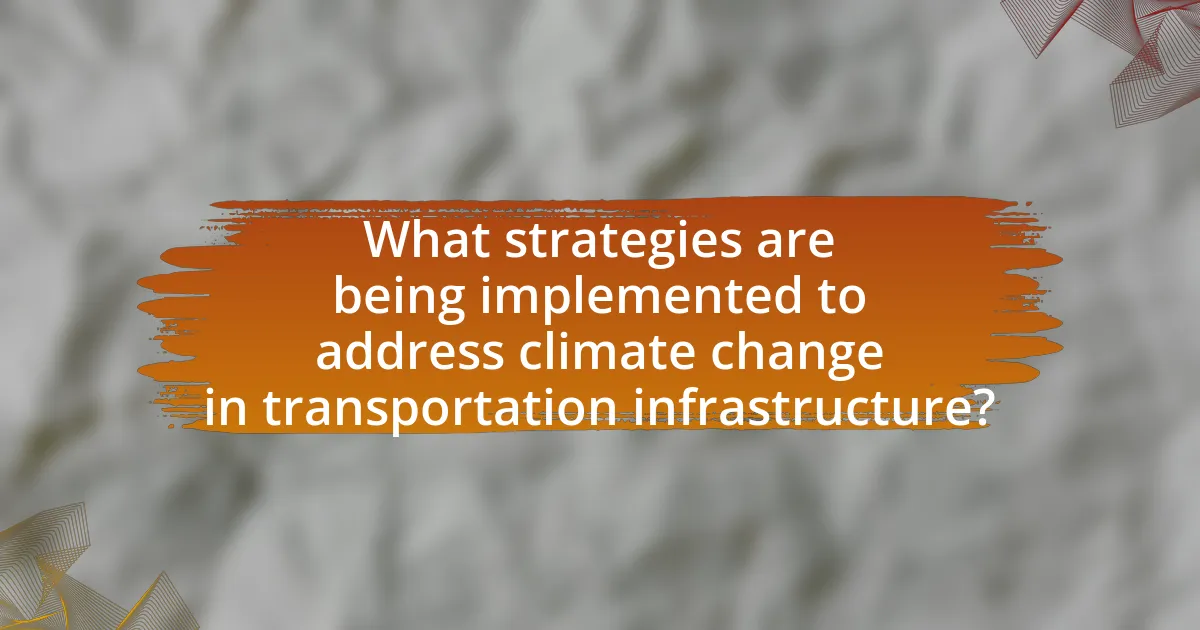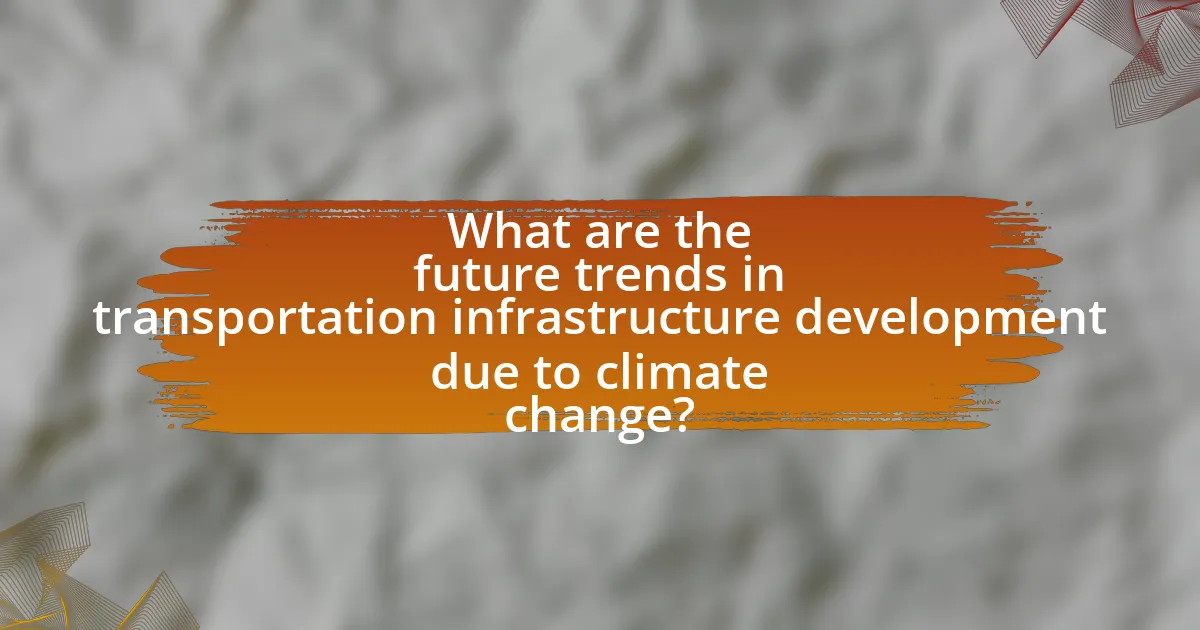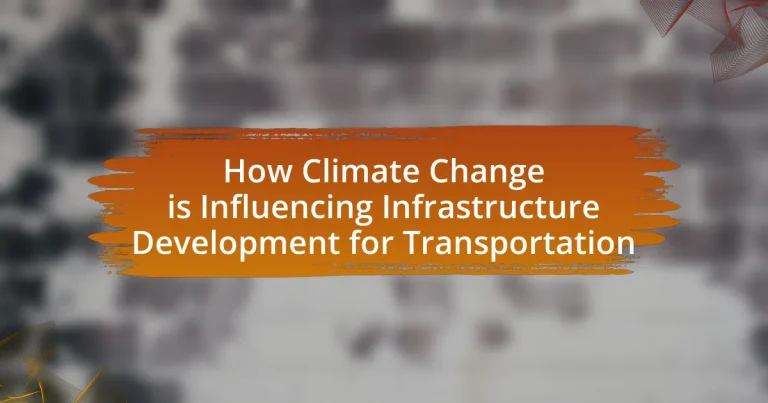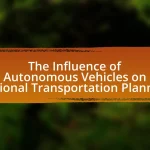Climate change is profoundly impacting transportation infrastructure development, necessitating the adoption of more resilient designs to withstand extreme weather events. Key issues include rising sea levels, increased flooding, and temperature fluctuations, which threaten the integrity of roads, bridges, and transit systems. The article explores the implications of these changes, highlighting the need for innovative materials, sustainable practices, and proactive government policies to enhance infrastructure resilience. It also discusses the economic consequences of inaction and the importance of adapting transportation systems to ensure public safety and efficiency in the face of climate challenges.

How is Climate Change Affecting Transportation Infrastructure Development?
Climate change is significantly affecting transportation infrastructure development by increasing the frequency and severity of extreme weather events, which necessitates more resilient designs. For instance, rising sea levels and increased flooding are prompting the redesign of coastal roads and bridges to withstand these conditions, as evidenced by the Federal Highway Administration’s report indicating that over 13,000 miles of roads in the U.S. are at risk of flooding by 2045. Additionally, temperature fluctuations are leading to the need for materials that can endure higher heat, as traditional asphalt can soften and deform under extreme temperatures. This shift in requirements is driving innovation in materials and construction practices to ensure infrastructure can cope with the changing climate.
What are the key impacts of climate change on transportation systems?
Climate change significantly impacts transportation systems by increasing the frequency and severity of extreme weather events, which can damage infrastructure and disrupt services. For instance, rising sea levels threaten coastal roads and bridges, while more intense storms can lead to flooding and landslides that obstruct transportation routes. According to the National Oceanic and Atmospheric Administration, the number of extreme weather events has increased by 40% over the past few decades, highlighting the urgency for transportation systems to adapt. Additionally, temperature fluctuations can affect the integrity of road surfaces and rail tracks, leading to increased maintenance costs and safety risks. The American Society of Civil Engineers estimates that climate-related damages to transportation infrastructure could exceed $1 trillion by 2040 if proactive measures are not taken.
How do extreme weather events influence infrastructure resilience?
Extreme weather events significantly weaken infrastructure resilience by exposing vulnerabilities in design and materials. For instance, increased flooding can lead to structural damage in roads and bridges, as evidenced by the 2017 Hurricane Harvey, which caused over $125 billion in damages, highlighting the inadequacy of existing infrastructure to withstand such events. Additionally, extreme heat can degrade materials like asphalt, leading to road buckling, as seen in the 2019 heatwave in Europe, where many roads required emergency repairs. These events necessitate a reevaluation of infrastructure planning and investment to enhance durability and adaptability in the face of climate change.
What role does rising sea levels play in transportation planning?
Rising sea levels significantly impact transportation planning by necessitating the reassessment of infrastructure resilience and location. As sea levels rise, areas previously deemed safe for transportation infrastructure may become vulnerable to flooding and erosion, leading planners to prioritize the construction of elevated roads, bridges, and flood-resistant designs. For instance, the National Oceanic and Atmospheric Administration (NOAA) projects that sea levels could rise by up to 6 feet by 2100 in some regions, prompting cities like Miami to invest in adaptive measures such as improved drainage systems and the relocation of critical transportation routes. This proactive approach ensures that transportation networks remain functional and safe in the face of climate change challenges.
Why is it important to adapt transportation infrastructure to climate change?
Adapting transportation infrastructure to climate change is crucial to ensure safety, reliability, and efficiency in transportation systems. Climate change increases the frequency and severity of extreme weather events, such as floods, hurricanes, and heatwaves, which can damage existing infrastructure and disrupt transportation networks. For instance, the National Oceanic and Atmospheric Administration reported that the U.S. experienced 22 separate billion-dollar weather and climate disasters in 2020 alone, highlighting the urgent need for resilient infrastructure. By proactively adapting transportation systems, communities can mitigate risks, reduce economic losses, and maintain mobility, ultimately supporting public safety and economic stability.
What are the potential economic consequences of inaction?
The potential economic consequences of inaction on climate change include significant infrastructure damage, increased repair costs, and reduced economic productivity. For instance, the National Oceanic and Atmospheric Administration reported that extreme weather events, exacerbated by climate change, caused over $1 trillion in damages in the United States from 1980 to 2020. Additionally, the World Bank estimates that climate-related disruptions could push over 100 million people into extreme poverty by 2030, further straining economic resources. Inaction can also lead to higher insurance premiums and decreased property values in vulnerable areas, ultimately impacting local and national economies.
How does climate change affect public safety in transportation?
Climate change significantly affects public safety in transportation by increasing the frequency and severity of extreme weather events, which can lead to hazardous conditions on roads and transit systems. For instance, rising sea levels and intensified storms can cause flooding, damaging infrastructure and disrupting transportation networks. According to the National Oceanic and Atmospheric Administration, the number of extreme weather events has increased by 30% over the past few decades, directly impacting the safety of transportation systems. Additionally, higher temperatures can lead to pavement buckling and increased vehicle breakdowns, further compromising public safety.

What strategies are being implemented to address climate change in transportation infrastructure?
Strategies being implemented to address climate change in transportation infrastructure include the adoption of sustainable materials, the integration of renewable energy sources, and the enhancement of public transit systems. Sustainable materials, such as recycled asphalt and low-carbon concrete, reduce the carbon footprint of construction projects. The integration of renewable energy sources, like solar panels on transit facilities, helps power operations sustainably. Additionally, enhancing public transit systems encourages reduced reliance on personal vehicles, which lowers greenhouse gas emissions. According to the American Public Transportation Association, increased public transit use can reduce individual carbon emissions by up to 45%.
How are governments responding to climate change in transportation planning?
Governments are responding to climate change in transportation planning by implementing policies that promote sustainable transportation systems and reduce greenhouse gas emissions. For instance, many governments are investing in public transit infrastructure, such as buses and trains, to decrease reliance on personal vehicles, which are significant contributors to carbon emissions. According to the International Energy Agency, public transport can reduce emissions by up to 45% per passenger kilometer compared to private cars. Additionally, governments are adopting electric vehicle (EV) incentives and expanding EV charging infrastructure to encourage the transition to cleaner vehicles. The European Union’s Green Deal aims to cut emissions from transport by 90% by 2050, showcasing a commitment to integrating climate considerations into transportation planning.
What policies are being enacted to promote sustainable infrastructure?
Governments worldwide are enacting policies to promote sustainable infrastructure by integrating climate resilience into transportation planning. For instance, the United States has implemented the Infrastructure Investment and Jobs Act, which allocates $7.5 billion for electric vehicle charging stations, aiming to reduce greenhouse gas emissions from transportation. Additionally, the European Union’s Green Deal emphasizes sustainable transport by proposing regulations that require a significant reduction in emissions from vehicles by 2030. These policies are designed to encourage investments in renewable energy sources and promote the use of public transportation, thereby addressing climate change impacts on infrastructure development.
How are funding and investment strategies evolving in response to climate change?
Funding and investment strategies are evolving to prioritize sustainable and resilient infrastructure in response to climate change. Investors are increasingly directing capital towards projects that mitigate climate risks, such as renewable energy, green transportation, and climate-resilient infrastructure. For instance, the Global Sustainable Investment Alliance reported that sustainable investment assets reached $35.3 trillion in 2020, reflecting a 15% increase over two years, indicating a significant shift towards environmentally responsible investment practices. Additionally, governments and financial institutions are implementing frameworks like the Task Force on Climate-related Financial Disclosures (TCFD) to enhance transparency and accountability in climate-related financial risks, further driving the evolution of funding strategies.
What innovative technologies are being utilized in transportation infrastructure development?
Innovative technologies utilized in transportation infrastructure development include smart traffic management systems, autonomous vehicles, and sustainable materials. Smart traffic management systems leverage real-time data analytics and IoT sensors to optimize traffic flow and reduce congestion, which is crucial in adapting to climate change impacts. Autonomous vehicles utilize advanced AI and machine learning algorithms to enhance safety and efficiency, potentially reducing emissions. Sustainable materials, such as recycled asphalt and eco-friendly concrete, are increasingly used to minimize environmental impact and improve resilience against climate-related stresses. These technologies collectively contribute to more efficient, sustainable, and resilient transportation infrastructure.
How do smart technologies enhance infrastructure resilience?
Smart technologies enhance infrastructure resilience by enabling real-time monitoring, predictive analytics, and automated responses to environmental changes. These technologies, such as IoT sensors and AI algorithms, allow for the continuous assessment of infrastructure conditions, which helps identify vulnerabilities and optimize maintenance schedules. For instance, a study by the National Academy of Sciences found that integrating smart sensors in transportation systems can reduce downtime by up to 30% during extreme weather events. This proactive approach not only mitigates damage but also ensures quicker recovery, thereby strengthening overall infrastructure resilience against climate change impacts.
What role does renewable energy play in transportation systems?
Renewable energy plays a crucial role in transportation systems by providing sustainable alternatives to fossil fuels, thereby reducing greenhouse gas emissions and dependence on non-renewable resources. The integration of renewable energy sources, such as solar, wind, and biofuels, into transportation infrastructure supports the transition to electric vehicles and public transit systems powered by clean energy. For instance, the International Energy Agency reported that electric vehicles, which can be powered by renewable energy, are expected to reach 145 million globally by 2030, significantly lowering carbon emissions in urban areas. This shift not only enhances energy security but also promotes environmental sustainability, aligning with global efforts to combat climate change.

What are the future trends in transportation infrastructure development due to climate change?
Future trends in transportation infrastructure development due to climate change include increased investment in resilient infrastructure, the integration of green technologies, and a shift towards multimodal transportation systems. Resilient infrastructure focuses on adapting existing roads, bridges, and transit systems to withstand extreme weather events, as evidenced by the Federal Highway Administration’s emphasis on climate resilience in its guidelines. The integration of green technologies, such as electric vehicle charging stations and renewable energy sources, is becoming essential, supported by the growing adoption of electric vehicles, which reached over 10 million globally in 2020. Additionally, multimodal transportation systems that combine various forms of transport, including public transit, cycling, and walking, are being prioritized to reduce carbon emissions and enhance urban mobility, as highlighted in the United Nations’ Sustainable Development Goals.
How will climate change shape urban transportation planning?
Climate change will significantly shape urban transportation planning by necessitating the integration of sustainability and resilience into infrastructure design. Urban planners will prioritize low-emission transportation options, such as electric public transit and cycling infrastructure, to reduce greenhouse gas emissions. Additionally, climate change impacts, such as increased flooding and extreme weather events, will require planners to design transportation systems that can withstand these challenges, leading to elevated roadways and improved drainage systems. According to the Intergovernmental Panel on Climate Change, cities that adopt climate-resilient transportation strategies can reduce vulnerability and enhance mobility, demonstrating the critical need for adaptive planning in response to climate change.
What are the implications for public transit systems?
Climate change significantly impacts public transit systems by necessitating infrastructure adaptations to withstand extreme weather events. Increased flooding, heatwaves, and storms require transit authorities to invest in resilient designs and materials to protect assets and ensure service continuity. For instance, the American Public Transportation Association reported that climate-related disruptions could cost transit agencies billions in repairs and lost revenue, highlighting the urgency for proactive measures. Additionally, shifting ridership patterns due to climate awareness may lead to increased demand for sustainable transit options, prompting agencies to enhance services like electric buses and bike-sharing programs.
How might infrastructure design evolve to accommodate climate resilience?
Infrastructure design will evolve to accommodate climate resilience by integrating adaptive materials, enhancing drainage systems, and implementing green infrastructure. Adaptive materials, such as permeable pavements and resilient concrete, will reduce vulnerability to extreme weather events. Enhanced drainage systems will be designed to manage increased rainfall and flooding, as evidenced by cities like New York, which has invested in stormwater management to mitigate flooding risks. Additionally, green infrastructure, including green roofs and urban forests, will be incorporated to improve air quality and reduce heat islands, as demonstrated by initiatives in cities like Philadelphia. These strategies collectively aim to create infrastructure that can withstand and adapt to the impacts of climate change.
What best practices can be adopted for sustainable transportation infrastructure?
Best practices for sustainable transportation infrastructure include the integration of multimodal transport systems, the use of renewable materials, and the implementation of green design principles. Multimodal transport systems enhance connectivity and reduce reliance on single-occupancy vehicles, which can decrease greenhouse gas emissions. The use of renewable materials, such as recycled asphalt and eco-friendly concrete, minimizes environmental impact during construction. Green design principles, such as incorporating green spaces and promoting energy-efficient technologies, further contribute to sustainability. According to the U.S. Green Building Council, buildings designed with sustainable practices can reduce energy consumption by up to 30%, demonstrating the effectiveness of these best practices in transportation infrastructure development.
How can stakeholders collaborate to enhance infrastructure resilience?
Stakeholders can collaborate to enhance infrastructure resilience by establishing integrated planning frameworks that prioritize climate adaptation and risk management. This collaboration involves government agencies, private sector partners, and community organizations working together to share data, resources, and best practices. For instance, the Federal Highway Administration emphasizes the importance of multi-stakeholder engagement in developing resilient transportation systems, highlighting that coordinated efforts can lead to more effective responses to climate-related challenges. By leveraging diverse expertise and resources, stakeholders can create infrastructure that is not only robust against current climate impacts but also adaptable to future changes.
What lessons can be learned from successful climate adaptation projects?
Successful climate adaptation projects demonstrate the importance of community engagement and stakeholder collaboration. Engaging local communities ensures that adaptation strategies are culturally relevant and address specific needs, as seen in the case of the Netherlands’ Room for the River program, which involved extensive public consultation and resulted in effective flood management solutions. Additionally, successful projects highlight the necessity of integrating scientific research with local knowledge, exemplified by the use of indigenous practices in Australia’s climate resilience initiatives, which have proven effective in managing natural resources. Furthermore, these projects underscore the value of flexibility and iterative planning, allowing for adjustments based on ongoing climate data and community feedback, as evidenced by the adaptive management strategies employed in California’s water resource management.


